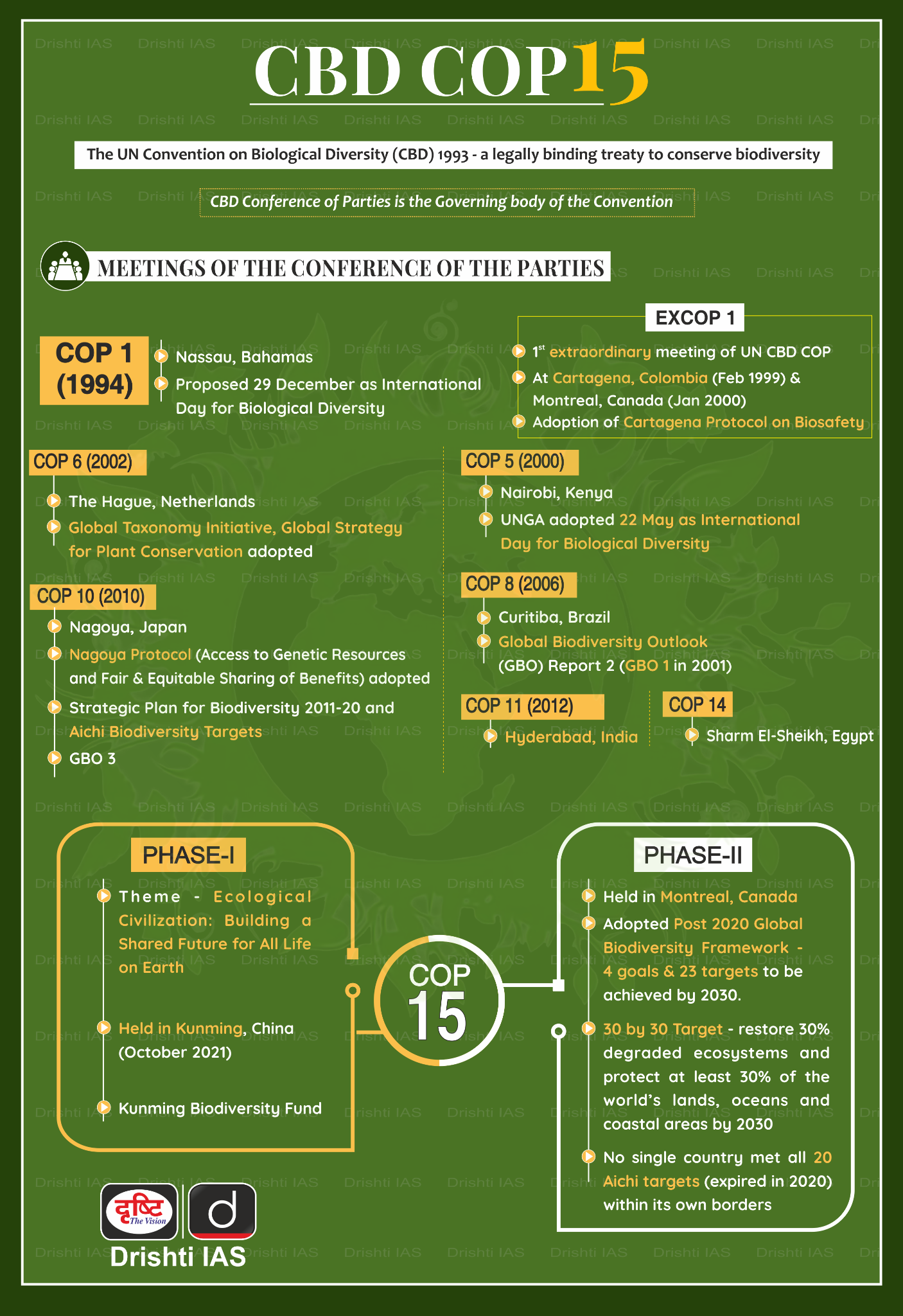Biodiversity & Environment
India’s Biodiversity Target Under CBD
- 15 Oct 2024
- 8 min read
For Prelims: National Biodiversity Targets, Convention on Biological Diversity, Kunming-Montreal Global Biodiversity Framework, Invasive Alien Species, Fair and Equitable Sharing, Sustainable Development Goals, Marine Ecosystem, Coastal Ecosystem, Aichi Biodiversity Targets (2011-2020), Seagrass Meadows, Other Effective Area-Based Conservation Measures (OECMs).
For Mains: Significance of the Kunming-Montreal Global Biodiversity Framework, India’s biodiversity targets.
Why in News?
Recently, India plans to submit its National Biodiversity Targets to the United Nations Convention on Biological Diversity (CBD) aligning with the Kunming-Montreal Global Biodiversity Framework (KMGBF).
- Article 6 of CBD calls all parties to prepare national strategies, plans or programmes for conservation and sustainable use of biodiversity.
- India is expected to submit its 23 biodiversity targets at the 16th Conference of the Parties to the CBD (CBD-COP 16) at Cali, Colombia.
What is India’s Biodiversity Target Under CBD?
- Conservation Areas: Aiming for 30% of areas to be effectively conserved to enhance biodiversity.
- Invasive Species Management: Targeting a 50% reduction in the introduction and establishment of invasive alien species.
- Rights and Participation: Ensuring the participation and rights of indigenous peoples, local communities, women, and youth in biodiversity conservation efforts.
- Sustainable Consumption: Enabling sustainable consumption choices and reducing food waste by half.
- Benefit Sharing: Promoting fair and equitable sharing of benefits from genetic resources, digital sequence information, and associated traditional knowledge.
- Pollution Reduction: Committing to reduce pollution, halving nutrient loss and pesticide risk.
- Biodiversity Planning: Ensuring that all areas are managed to reduce the loss of regions of high biodiversity importance.
What is the Kunming-Montreal Global Biodiversity Framework (KMGBF)?
- About: It is a multilateral treaty aimed at halting and reversing biodiversity loss globally by 2030.
- It was adopted in December 2022 during the 15th meeting of the Conference of the Parties (CoP).
- It supports the Sustainable Development Goals (SDGs) and builds upon the achievements and lessons learned from the Strategic Plan for Biodiversity 2011–2020.
- Purpose and Goals: It ensures that by 2030 at least 30% of areas of degraded terrestrial, inland water, and marine and coastal ecosystems are under effective restoration.
- It has 23 action-oriented global targets for urgent action over the decade to 2030 which will enable achievement towards the outcome-oriented goals for 2050.
- It is important to note that this target refers to collective global efforts rather than a requirement for each country to allocate 30% of its land and water areas.
- Long-Term Vision: The framework envisions that by 2050, there will be a collective commitment to living in harmony with nature, serving as a foundational guide for current actions and policies on biodiversity conservation and sustainable use.
Development of National Biodiversity Targets (NBTs)
- Aichi Biodiversity Targets: In response to the CBD obligations, India has developed 12 national biodiversity targets (NBTs) that align with the previous Aichi Biodiversity Targets (2011-2020).
- National Biodiversity Action Plan (NBAP): It was originally created in 2008 and updated in 2014 to incorporate Aichi Biodiversity Targets.
- Monitoring: Associated indicators and monitoring framework has also been developed by India to provide a roadmap for achieving the NBTs.
How India Can Achieve the New Biodiversity Goals?
- Habitat Connectivity: India needs to prioritise the conservation of neglected ecosystems such as grasslands, wetlands, and seagrass meadows.
- Well-connected protected areas integrated into broader landscapes and seascapes can facilitate the movement of species and promote biodiversity.
- Mobilising Financial Resources: India should continue to advocate for financial support from developed nations to implement its national biodiversity action plans effectively.
- The GBF calls for developed countries to mobilise at least USD 20 billion annually by 2025 and USD 30 billion by 2030 for biodiversity initiatives in developing countries.
- Co-Management Models: Developing co-management frameworks that involve indigenous peoples and local communities in the conservation process can enhance the effectiveness of protected areas while maintaining community livelihoods.
- Integrating OECMs: Shifting focus from traditional protected areas to other effective area-based conservation measures (OECMs) allows for the conservation of biodiversity in areas with fewer restrictions on human activity.
- It includes supporting traditional agricultural systems and privately owned lands that contribute to conservation goals.
- Reforming Agricultural Subsidies: India should redirect support from harmful practices, such as pesticide use, to sustainable alternatives that promote ecosystem health.
- Alignment with Previous Targets: Building on the existing National Biodiversity Action Plan (NBAP) and aligning it with the new 23 targets of the GBF will create a cohesive strategy for biodiversity conservation in India.
Conclusion
India's commitment to the Kunming-Montreal Global Biodiversity Framework through its 23 biodiversity targets reflects a strategic approach to conserving ecosystems and enhancing community participation. By prioritising neglected habitats, mobilising resources, and reforming subsidies, India can effectively work towards achieving its biodiversity goals by 2030.
|
Drishti Mains Question: Discuss the significance of the Kunming-Montreal Global Biodiversity Framework (KMGBF) for global biodiversity conservation. |
UPSC Civil Services Examination Previous Year Question (PYQ)
Prelims
Q. With reference to ‘Global Environment Facility’, which of the following statements is/are correct?
(a) It serves as financial mechanism for ‘Convention on Biological Diversity’ and ‘United Nations Framework Convention on Climate Change’
(b) It undertakes scientific research on environmental issues at global level
(c) It is an agency under OECD to facilitate the transfer of technology and funds to underdeveloped countries with specific aim to protect their environment
(d) Both (a) and (b)
Ans: (a)
Q.“Momentum for Change: Climate Neutral Now” is an initiative launched by (2018)
(a) The Intergovernmental Panel on Climate Change
(b) The UNEP Secretariat
(c) The UNFCCC Secretariat
(d) The World Meteorological Organisation
Ans: (c)
Mains
Q. How is the Government of India protecting traditional knowledge of medicine from patenting by pharmaceutical companies? (2019)





